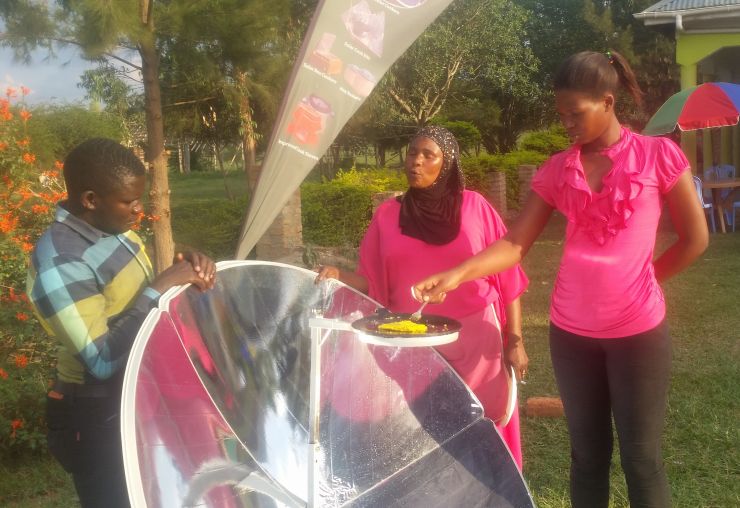
Myth busting solar cooking

An omelet being made on a solar cooking restaurant in Uganda.
Photo Credit: SCI Global Advisor Kawesa Mukasa
SCI appreciates the ability to share solar cooking information for novices and experts. Here are some common misconceptions about solar cooking and the truth behind them. For more information, please visit the world’s largest online database of solar cooking information here, especially this Frequently Asked Questions page. Thank you.
You cannot solar cook without sunshine
- Heat-retained baskets allow one to effectively continue solar cooking when the sun dims, is masked by clouds, or at the end of the day.
- Solar box ovens are insulated and can still work on partly cloudy days.
- Thermal storage methods exist and research and development groups are pursuing the commercialization of thermal batteries.
You cannot control the temperature when cooking
-
There are ways to adjust the temperature of a solar cooker. For example, on many different solar cooker models, you can use reflectors (or not), you can change the position of the cooker relative to the sun rays, you can use lids (or not), you can adjust how tight the heat seal is, etc. to adjust the temperature while cooking
Solar cooking is expensive
- Solar cooking has zero cost for fuel. When fuel cost is considered for other modes of cooking, solar cooking offers an economical solution, in comparison.
- You can make your own solar cooker for little to no cost by using materials found locally (maybe even in your own home); here are some open-source designs: http://www.solarcooking.org/plans/
Most developing countries cannot afford it without government subsidies
- There are best ways to have solar cookers available and affordable for people with low/limited income without subsidies. If needed, initial external support can help establish new solar cooker entrepreneurs in developing areas (to get up and running) until they are financially sustainable and can produce affordable solar cookers using local materials. This process generates successful models useful for furthering the global solar cooking movement.
- There have been successful approaches with a “pay as you go” with savings from funds that would otherwise be spent on more expensive types of fuel. Learn more about various funding approaches here https://solarcooking.fandom.com/wiki/Business_development
Solar cookers are not appropriate in regions that experience monsoon seasons
- Yes, there are monsoon seasons in East Africa and in other parts of the world. But then there are many more months per year outside of the monsoon seasons with days that are suitable for solar cooking. Also, during the monsoon season, after it rains, it is common for the sun to come out.
Solar cookers are slow and cannot cook all types of food
- Parabolic cookers are powerful cookers that can cook food as fast as when using a gas burner.
- There are various types of solar cookers, each suitable for a range of ethnic foods
Solar cookers are not useful because they do not work when it rains or at night.
- Solar cookers are intended as an integrated solution, to be added to cooking solutions that already exist in one’s home. Using solar cookers can reduce fuel typically used in other cooking systems.
- Solar cook on sunny days, use other cooking modes at times where there is no sun.
You have to be outside in the sun when you solar cook
- For most solar cooking, the solar cooker needs to be in the sun, but the solar cook does not need to stay in the sun. After a solar cook places their solar cooker in the sun in an area next to their home, they can return indoors to continue with daily tasks.
- When solar cooking while away from home, a solar cook can place their solar cooker in the sun and then seek shade to carry out other tasks while their food cooks in the sun.
- Some parabolic and Fresnel-lens-based solar cookers have a canopy that shelters the solar cook from direct sunlight when direct cooking attendance is necessary.
- Institutional roof-top-mounted solar cooking systems use solar-heated fluid to transfer heat to indoor kitchens for cooking
You cannot solar cook during the wintertime at northern latitudes
- Solar irradiation can be greater during wintertime in North America, for instance, because cold air is dryer with less humidity – lower humidity means few water particles in the air to scatter light. A well-insulated solar cooker can overcome freezing temperatures for solar cooking on sunny winter days.
- Even on days with frost-bite warnings, one can solar cook indoors by placing their solar cooker in the sunlight streaming through a South-facing window.
Solar cooking is such a powerful solution. Thank you for empowering people all around the world with up-to-date and accurate information on solar cooking, with your support.